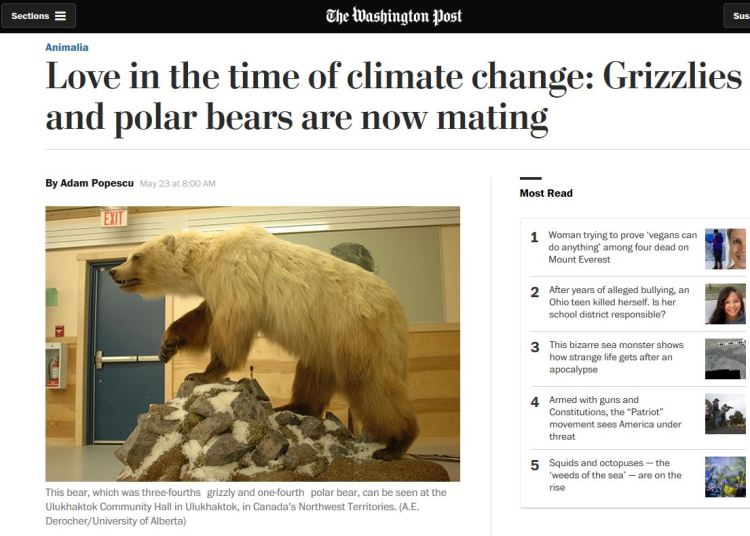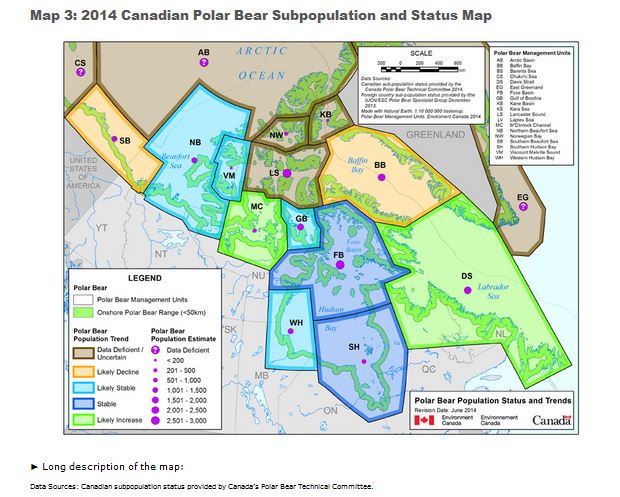‘Nonesense’: Polar Bear researcher rips media reports of Grizzlies & Polar Bears mating due to ‘climate change’
Five facts that challenge polar bear hybridization nonsense
It was inevitable, I suppose, that the putative hybrid shot in Arviat,Nunavut last week (see my post here) would initiate the global warming blame game.

Washington Post, 23 May 2016, Adam Popescu: “Love in the time of climate change: Grizzlies and polar bears are now mating”
Here are the five points you need to know about polar bear hybridization, as there are several nonsense statements contained in this Washington Post article.
1) POLAR BEAR TERRITORY IS NOT CONTRACTING
Steven Amstrup, head spokesperson for Polar Bears International (“Save Our Sea Ice!”)
“[Steven Amstrup], like other experts, characterizes this “new” bear relationship as more beneficial to grizzlies than polar bears. That’s because there are more grizzlies than polar bears and because grizzly territory is expanding while polar bear territory is contracting. What that adds up to is a good chance grizzlies could essentially dilute the polar bear population until it doesn’t exist at all, they say.”
“Polar bear territory is contracting” is a nonsense statement that is totally false. I dealt with a related claim here.
Territory might be prophesied to contract decades from now but so far,i t hasn’t changed a bit as a result of sea ice changes since 1950.The regions where hybridization has been documented (Doupé et al. 2007, see map in refs. below) are still polar bear territory, as is the region where the latest putative hybrid was shot (still not confirmed by DNA). All of the polar bear regions adjacent to grizzly populations in Canada have stable or increasing polar bear populations.

2) GRIZZLIES INVADING THE W. HUDSON BAY COAST ARE MOVING SOUTH
Derocher:
“It shouldn’t be a big surprise that grizzlies are moving north — everything is.”
Map below shows where grizzly populations are found in Central and Northern Canada (according to the SARA Registry, 2012 – see table copied below). If a grizzly male met a polar bear female along western Hudson Bay (which is the most recent putative hybridization event took place and where more grizzlies have been seen in recent years), it could only have come from the north.

The population table below is from the SARA Registry about grizzlies in Canada, which shows “few” grizzlies
Scientists slam Bill Nye: He ‘has dangerously misled the whole generation of younger minds’
Popular personalities like Mr. Bill Nye have had all the attention of the microphones, loudspeakers, and print media, and he has dangerously misled the whole generation of unsuspected readers and younger minds. As scientists, it is our duty to denounce such an attitude, to stop scientism and to warn everyone that personalities like Mr. Nye are plainly anti-science and, therefore, will harm us all.
Willie Soon is an independent scientist who has been studying the Sun and Earth climate for the past 26 years. István Markó is a professor of chemistry at the Université catholique de Louvain and director of the Organic and Medicinal Chemistry Laboratory.
The latest EIA CO2 emissions data shows that the U.S. is not a significant contributor to increasing global CO2 emissions.
The latest EIA CO2 emissions data shows that the U.S. is not a significant contributor to increasing global CO2 emissions.
U.S. overall energy related emissions are 12% below 2005 levels, and electricity generated related emissions are that of 1993. Guest essay by Larry Hamlin EIA data and analysis shows that U.S. CO2 emissions peaked in the years 2005 and 2007 at about 6 billion metric tons per year and have steadily declined since then with […]
— gReader Pro…
Professor: ‘Madness’ of fighting global warming will impoverish everyone
Professor: ‘Madness’ of fighting global warming will impoverish everyone
Cambridge University electrical engineering professor Dr. M.J. Kelly concluded in a peer-reviewed journal article that attempts to fight global warming with green energy will impoverish the world.
— gReader Pro…
Renowned Economics Prof On Climate Model-Based Policy: No “Need To Be A Denier To Qualify It As Methodological Nonsense”!
Renowned Economics Prof On Climate Model-Based Policy: No “Need To Be A Denier To Qualify It As Methodological Nonsense”!
The online Swiss Neue Zürcher Zeitung (NZZ) has published a commentary by renowned economics professor Silvio Borner, University of Basel, where he sharply criticizes climate models and basing political decisions on them. Photo: University Basel, Peter Schnetz He compares climate forecasts to economic forecasts, where in both fields one runs into a myriad of unpredictable variables and complex, poorly understood interactions that make reliable forecasts impossible – even more so in climate. When it comes to climate, Borner writes that it is a fact the current warming started before industrialization and that CO2 is “partly responsible” for the current warming – as scientifically accepted temperature reconstructions of the past show. In his commentary he looks at the parallels between global economy and global climate, reminding us that we already know that there are huge margins of errors for even short-term forecasts. “They often err even on the algebraic sign“. Interestingly, Borner writes that forcasting the climate system is even more difficult because “we do not know the unknown exogenic causal factors in advance nor are we able to control them politically“. He explains that economists have had (bitter) experiences in trying to forecast economies and that the climate system is an even more unfamiliar system. This is evident, he says, even from weather forecasts which “differ from model to model and are often wrong“. On the usefulness of models, Borner says they are of value, but never “true” due to the numerous assumptions that go into them. He writes: For these reasons, all the ‘doom prognoses’ concerning the limits of growth have all failed grandly.” Due to all the unknowns in the climate system, and the extreme lack of understanding with regards to their interaction, Borner says it is “scientifically irresponsible to fix a relationship between CO2 emissions and global warming, and then calculate from that how much Co2 needs to reduced by 2030 in order to avoid a 2°C temperature rise.” He adds: To qualify that as methodological nonsense, one does not have to be a ‘climate denier’.” Borner believes that it makes sense to reduce CO2, “but not on the backs of the poor countries“. He favors a CO2 emissions certificate trading scheme. He concludes: It is enough to set down the right general framework conditions. State planning …
Season Approaches: U.S. Hits Record 127 Months Since Major Hurricane Strike
With hurricane season set to start next week, Tuesday marks a record 127 months since a major hurricane has made landfall in the continental United States, according to statistics compiled by the National Oceanic and Atmospheric Administration’s (NOAA) Hurricane Research Division, which keeps data on all the hurricanes that have struck the U.S. since 1851.
The last major hurricane (defined as a Category 3 or above) to hit the U.S. mainland was Hurricane Wilma, which made landfall in Florida on Oct. 24, 2005.
Although a major hurricane typically strikes the U.S. about once every two years, no major hurricanes have made landfall in the U.S. for more than 10 and a half years.
The second longest stretch between major hurricane strikes was between the major hurricane that struck in August 1860 and the one that struck in September 1869, NOAA records show. The third longest stretch was between the major hurricane that struck in September 1900 and the one that struck in October 1906.
Wilma was one of four major hurricanes – including Hurricanes Dennis (July 10, 2005), Katrina (Aug. 29, 2005) and Rita (Sept. 24, 2005) – that came ashore in the U.S. during the 2005 hurricane season. (The season starts on June 1 and runs through November 30.)
Hurricanes Wilma, Rita and Katrina killed almost 4,000 people and caused an estimated $160 billion in damage that year, making it “one of the most active hurricane seasons in recorded history,” NOAA said in a statement marking the 10-year anniversary of the 2005 hurricane season.…
